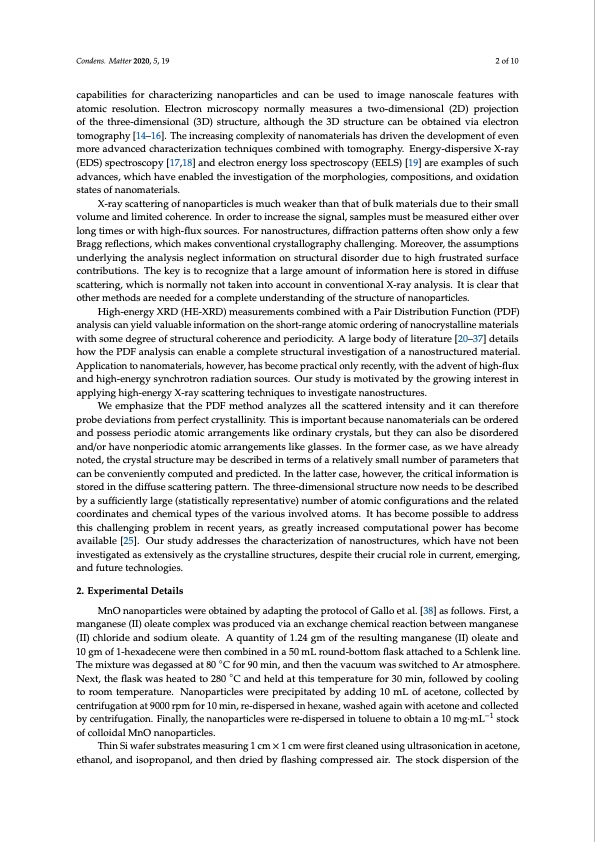
PDF Publication Title:
Text from PDF Page: 002
Condens. Matter 2020, 5, 19 2 of 10 capabilities for characterizing nanoparticles and can be used to image nanoscale features with atomic resolution. Electron microscopy normally measures a two-dimensional (2D) projection of the three-dimensional (3D) structure, although the 3D structure can be obtained via electron tomography [14–16]. The increasing complexity of nanomaterials has driven the development of even more advanced characterization techniques combined with tomography. Energy-dispersive X-ray (EDS) spectroscopy [17,18] and electron energy loss spectroscopy (EELS) [19] are examples of such advances, which have enabled the investigation of the morphologies, compositions, and oxidation states of nanomaterials. X-ray scattering of nanoparticles is much weaker than that of bulk materials due to their small volume and limited coherence. In order to increase the signal, samples must be measured either over long times or with high-flux sources. For nanostructures, diffraction patterns often show only a few Bragg reflections, which makes conventional crystallography challenging. Moreover, the assumptions underlying the analysis neglect information on structural disorder due to high frustrated surface contributions. The key is to recognize that a large amount of information here is stored in diffuse scattering, which is normally not taken into account in conventional X-ray analysis. It is clear that other methods are needed for a complete understanding of the structure of nanoparticles. High-energy XRD (HE-XRD) measurements combined with a Pair Distribution Function (PDF) analysis can yield valuable information on the short-range atomic ordering of nanocrystalline materials with some degree of structural coherence and periodicity. A large body of literature [20–37] details how the PDF analysis can enable a complete structural investigation of a nanostructured material. Application to nanomaterials, however, has become practical only recently, with the advent of high-flux and high-energy synchrotron radiation sources. Our study is motivated by the growing interest in applying high-energy X-ray scattering techniques to investigate nanostructures. We emphasize that the PDF method analyzes all the scattered intensity and it can therefore probe deviations from perfect crystallinity. This is important because nanomaterials can be ordered and possess periodic atomic arrangements like ordinary crystals, but they can also be disordered and/or have nonperiodic atomic arrangements like glasses. In the former case, as we have already noted, the crystal structure may be described in terms of a relatively small number of parameters that can be conveniently computed and predicted. In the latter case, however, the critical information is stored in the diffuse scattering pattern. The three-dimensional structure now needs to be described by a sufficiently large (statistically representative) number of atomic configurations and the related coordinates and chemical types of the various involved atoms. It has become possible to address this challenging problem in recent years, as greatly increased computational power has become available [25]. Our study addresses the characterization of nanostructures, which have not been investigated as extensively as the crystalline structures, despite their crucial role in current, emerging, and future technologies. 2. Experimental Details MnO nanoparticles were obtained by adapting the protocol of Gallo et al. [38] as follows. First, a manganese (II) oleate complex was produced via an exchange chemical reaction between manganese (II) chloride and sodium oleate. A quantity of 1.24 gm of the resulting manganese (II) oleate and 10 gm of 1-hexadecene were then combined in a 50 mL round-bottom flask attached to a Schlenk line. The mixture was degassed at 80 ◦C for 90 min, and then the vacuum was switched to Ar atmosphere. Next, the flask was heated to 280 ◦C and held at this temperature for 30 min, followed by cooling to room temperature. Nanoparticles were precipitated by adding 10 mL of acetone, collected by centrifugation at 9000 rpm for 10 min, re-dispersed in hexane, washed again with acetone and collected by centrifugation. Finally, the nanoparticles were re-dispersed in toluene to obtain a 10 mg·mL−1 stock of colloidal MnO nanoparticles. Thin Si wafer substrates measuring 1 cm × 1 cm were first cleaned using ultrasonication in acetone, ethanol, and isopropanol, and then dried by flashing compressed air. The stock dispersion of thePDF Image | Structure of Manganese Oxide Nanoparticles Extracted via Pair Distribution Functions

PDF Search Title:
Structure of Manganese Oxide Nanoparticles Extracted via Pair Distribution FunctionsOriginal File Name Searched:
condensedmatter-05-00019-v2.pdfDIY PDF Search: Google It | Yahoo | Bing
Sulfur Deposition on Carbon Nanofibers using Supercritical CO2 Sulfur Deposition on Carbon Nanofibers using Supercritical CO2. Gamma sulfur also known as mother of pearl sulfur and nacreous sulfur... More Info
CO2 Organic Rankine Cycle Experimenter Platform The supercritical CO2 phase change system is both a heat pump and organic rankine cycle which can be used for those purposes and as a supercritical extractor for advanced subcritical and supercritical extraction technology. Uses include producing nanoparticles, precious metal CO2 extraction, lithium battery recycling, and other applications... More Info
| CONTACT TEL: 608-238-6001 Email: greg@infinityturbine.com | RSS | AMP |